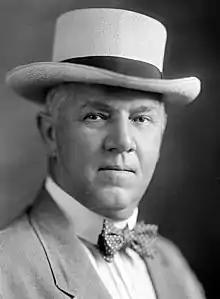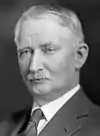Nebraska's 2nd congressional district
Nebraska's 2nd congressional district is a congressional district in the U.S. state of Nebraska that encompasses the core of the Omaha–Council Bluffs metropolitan area. It includes all of Douglas County, which includes Omaha, as well as the suburban areas of the western part of Sarpy County. It has been represented in the United States House of Representatives since 2017 by Don Bacon, a member of the Republican Party.
| Nebraska's 2nd congressional district | |||
|---|---|---|---|
.tif.png.webp) Nebraska's 2nd congressional district since January 3, 2013 | |||
| Representative |
| ||
| Distribution |
| ||
| Population (2019) | 684,882 | ||
| Median household income | $71,277[1] | ||
| Ethnicity |
| ||
| Cook PVI | R+4[2] | ||
Demographics
According to the APM Research Lab's Voter Profile Tools[3] (featuring the U.S. Census Bureau's 2019 American Community Survey), the district contained about 473,000 potential voters (citizens, age 18+). Of these, 80% are White, 9% Black, and 6% Latino. Immigrants make up 5% of the district's potential voters. Median income among households (with one or more potential voter) in the district is about $73,400, while 8% of households live below the poverty line. As for the educational attainment of potential voters in the district, 40% hold a bachelor's or higher degree.
Electoral vote in presidential elections
Nebraska and Maine are the only two states in the United States which distribute their electoral votes for president based on presidential candidates' performance in their respective congressional districts in addition to their statewide performance. The statewide popular vote winner for president receives two electoral votes, and the winner of each of Nebraska's congressional districts—there are currently three such districts—receives an electoral vote from the respective district.
While the rest of the state's electorate tends to be solidly Republican, the 2nd district, being centered on the city of Omaha, is much more closely divided between the two main parties—Republican and Democratic.
In the 2008 United States presidential election, Democratic presidential candidate Barack Obama targeted the district as a strategy of breaking a potential electoral-vote tie.[4] He won the district's electoral vote by a margin of 3,325 votes over his chief general election opponent, Republican John McCain.[5] However, McCain won Nebraska's statewide popular vote, as well as the district-wide popular vote for the other two Nebraska congressional districts, thus receiving four electoral votes from Nebraska.[5]
Obama's victory in the 2nd district meant that Nebraska's electoral delegation was split for the first time ever. It also marked the first Nebraskan electoral vote for a Democrat since 1964.[5] By contrast, in 2012 and 2016, Republican presidential nominees Mitt Romney and Donald Trump won the 2nd district, as well as the overall statewide vote and the electoral votes of the first and third districts.[6] The district flipped back to the Democratic Party in 2020, giving its one electoral vote to Joe Biden.[7]
Recent elections
This district is known as a swing district; it was one of six districts with a margin of less than 5% in all four elections after the 2010 Census. It has also backed the overall winner of every presidential election who won the Electoral College vote since 2000, except for when it voted for the losing candidate Mitt Romney over Barack Obama in 2012.
2006 election
| Party | Candidate | Votes | % | ±% | |
|---|---|---|---|---|---|
| Republican | Lee Terry (Incumbent) | 99,475 | 54.7% | −6.4% | |
| Democratic | Jim Esch | 82,504 | 45.3% | +9.1% | |
| Republican hold | Swing | ||||
| Turnout | 181,979 | ||||
2008 election
| Party | Candidate | Votes | % | ±% | |
|---|---|---|---|---|---|
| Republican | Lee Terry (Incumbent) | 142,473 | 51.9% | −2.8% | |
| Democratic | Jim Esch | 131,901 | 48.1% | +2.8% | |
| Republican hold | Swing | ||||
| Turnout | 274,374 | ||||
2010 election
| Party | Candidate | Votes | % | ±% | |
|---|---|---|---|---|---|
| Republican | Lee Terry (Incumbent) | 93,840 | 60.8% | +8.9% | |
| Democratic | Tom White | 60,486 | 39.2% | −8.9% | |
| Republican hold | Swing | ||||
| Turnout | 154,326 | ||||
2012 election
| Party | Candidate | Votes | % | ±% | |
|---|---|---|---|---|---|
| Republican | Lee Terry (Incumbent) | 133,964 | 50.8% | −10.0% | |
| Democratic | John Ewing | 129,767 | 49.2% | +10.0% | |
| Republican hold | Swing | ||||
| Turnout | 263,731 | ||||
2014 election
| Party | Candidate | Votes | % | ±% | |
|---|---|---|---|---|---|
| Democratic | Brad Ashford | 83,872 | 49.0% | −0.2% | |
| Republican | Lee Terry (Incumbent) | 78,157 | 45.7% | −5.1% | |
| Libertarian | Steven Laird | 9,021 | 5.3% | +5.3% | |
| Democratic gain from Republican | Swing | ||||
| Turnout | 171,050 | ||||
2016 election
| Party | Candidate | Votes | % | ±% | |
|---|---|---|---|---|---|
| Republican | Don Bacon | 141,066 | 48.9% | +3.2% | |
| Democratic | Brad Ashford (Incumbent) | 137,602 | 47.7% | −1.3% | |
| Libertarian | Steven Laird | 9,640 | 3.3% | −2.0% | |
| Republican gain from Democratic | Swing | ||||
| Turnout | 288,308 | ||||
2018 election
| Party | Candidate | Votes | % | ±% | |
|---|---|---|---|---|---|
| Republican | Don Bacon (Incumbent) | 126,715 | 51.0% | +2.1% | |
| Democratic | Kara Eastman | 121,770 | 49.0% | +1.3% | |
| Republican hold | Swing | ||||
| Turnout | 248,485 | ||||
2020 election
| Party | Candidate | Votes | % | ±% | |
|---|---|---|---|---|---|
| Republican | Don Bacon (Incumbent) | 171,071 | 50.8% | -0.2% | |
| Democratic | Kara Eastman | 155,706 | 46.2% | -2.8% | |
| Libertarian | Tyler Schaeffer | 10,185 | 3% | +3% | |
| Republican hold | Swing | ||||
| Turnout | 336,962 | ||||
Redistricting
In 2011, Nebraska lawmakers changed the district to excise Offutt Air Force Base and the city of Bellevue — an area with a large minority population — and moved the borders to include the Republican-heavy Omaha suburbs in Sarpy County. The move was expected to dilute the city's urban Democratic vote, which Democrats criticized as gerrymandering.[8]
List of members representing the district
Election results from presidential races
| Year | Office | Results |
|---|---|---|
| 2000 | President | George W. Bush 57% – Al Gore 39% |
| 2004 | President | George W. Bush 60% – John Kerry 38% |
| 2008 | President | Barack Obama 50% – John McCain 49% |
| 2012 | President | Mitt Romney 53% – Barack Obama 46% |
| 2016 | President | Donald Trump 48% – Hillary Clinton 46% |
| 2020 | President | Joe Biden 52% – Donald Trump 46% |
Historical district boundaries

References
- Center for New Media & Promotion (CNMP), US Census Bureau. "My Congressional District". www.census.gov.
- "Partisan Voting Index – Districts of the 115th Congress" (PDF). The Cook Political Report. April 7, 2017. Retrieved April 7, 2017.
- "Representing US: 2020 Voter Profiles". APM Research Lab. Retrieved 2020-10-22.
- Curry, Tom (2008-11-02). "Is Obama-Terry the winning ticket in Omaha?". NBC News. Retrieved 2008-11-20.
If the national electoral vote tally is close, then the one electoral vote in Omaha would loom large. But with Obama apparently ahead in competitive states such as Virginia, the presidency may not hinge on Omaha's vote.
- Staff reporter (2008-11-14). "Obama wins 1 of Nebraska's electoral votes". AP. Retrieved 2009-10-17. (Archived by WebCite at https://www.webcitation.org/5kaEXuAwS)
- Walton, Don (2012-11-07). "Romney wins 2nd District electoral vote". Lincoln Journal Star. Retrieved 2012-11-07.
Republican nominee Mitt Romney appeared to have won the battle for Nebraska's only competitive presidential electoral vote Tuesday night. [...] Romney held comfortable leads in both the 1st District, which includes Lincoln, and the vast 3rd District, as well as statewide.
(Archived by WebCite at https://www.webcitation.org/6Bzdk9RLy) - https://www.washingtonpost.com/
- Schulte, Grant (May 27, 2011). "Nebraska Redistricting Maps Approved". AP. Retrieved August 10, 2012.
- Martis, Kenneth C. (1989). The Historical Atlas of Political Parties in the United States Congress. New York: Macmillan Publishing Company.
- Martis, Kenneth C. (1982). The Historical Atlas of United States Congressional Districts. New York: Macmillan Publishing Company.
- Congressional Biographical Directory of the United States 1774–present
.jpg.webp)
.jpg.webp)
.jpg.webp)


.jpg.webp)







.jpg.webp)

.jpg.webp)








